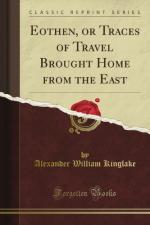Often enough I saw the ghostly images of the women with their exalted horns stalking through the streets, and I saw too in travelling the affrighted groups of the mountaineers as they fled before me, under the fear that my party might be a company of income-tax commissioners, or a pressgang enforcing the conscription for Mehemet Ali; but nearly all my knowledge of the people, except in regard of their mere costume and outward appearance, is drawn from books and despatches, to which I have the honour to refer you.
I received hospitable welcome at Beyrout from the Europeans as well as from the Syrian Christians, and I soon discovered that their standing topic of interest was the Lady Hester Stanhope, who lived in an old convent on the Lebanon range, at the distance of about a day’s journey from the town. The lady’s habit of refusing to see Europeans added the charm of mystery to a character which, even without that aid, was sufficiently distinguished to command attention.
Many years of Lady Hester’s early womanhood had been passed with Lady Chatham at Burton Pynsent, and during that inglorious period of the heroine’s life her commanding character, and (as they would have called it in the language of those days) her “condescending kindness” towards my mother’s family, had increased in them those strong feelings of respect and attachment, which her rank and station alone would have easily won from people of the middle class. You may suppose how deeply the quiet women in Somersetshire must have been interested, when they slowly learned by vague and uncertain tidings that the intrepid girl who had been used to break their vicious horses for them was reigning in sovereignty over the wandering tribes of Western Asia! I know that her name was made almost as familiar to me in my childhood as the name of Robinson Crusoe—both were associated with the spirit of adventure; but whilst the imagined life of the cast-away mariner never failed to seem glaringly real, the true story of the Englishwoman ruling over Arabs always sounded to me like fable. I never had heard, nor indeed, I believe, had the rest of the world ever heard, anything like a certain account of the heroine’s adventures; all I knew was, that in one of the drawers which were the delight of my childhood, along with attar of roses and fragrant wonders from Hindustan, there were letters carefully treasured, and trifling presents which I was taught to think valuable because they had come from the queen of the desert, who dwelt in tents, and reigned over wandering Arabs.
This subject, however, died away, and from the ending of my childhood up to the period of my arrival in the Levant, I had seldom even heard a mentioning of the Lady Hester Stanhope, but now, wherever I went, I was met by the name so familiar in sound, and yet so full of mystery from the vague, fairy-tale sort of idea which it brought to my mind; I heard it, too, connected with fresh wonders, for it was said that the woman was now acknowledged as an inspired being by the people of the mountains, and it was even hinted with horror that she claimed to be more than A prophet.




